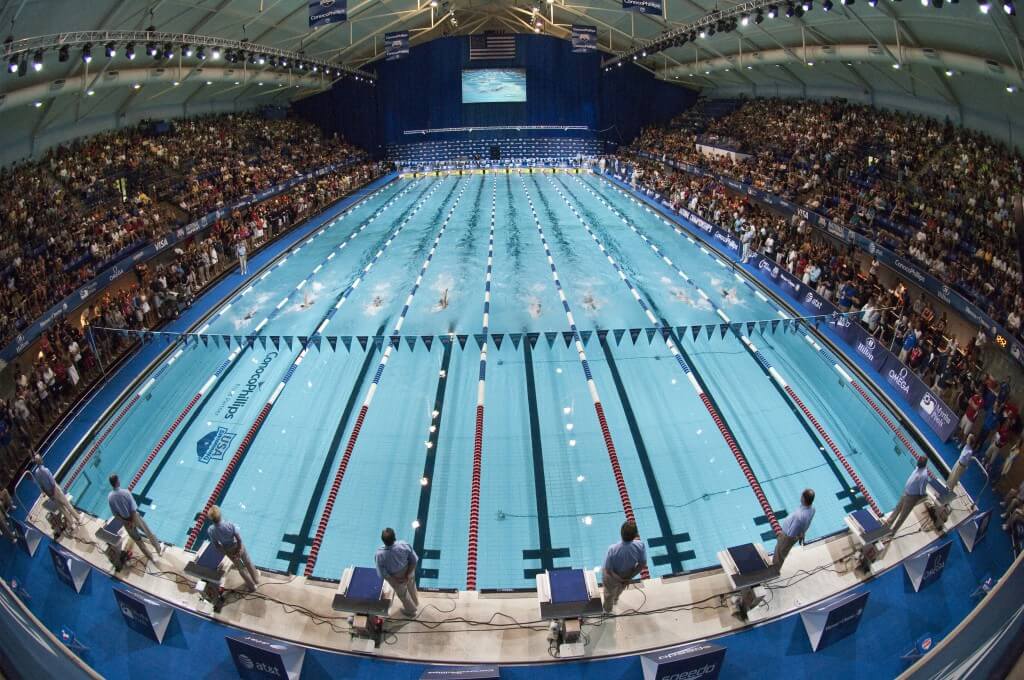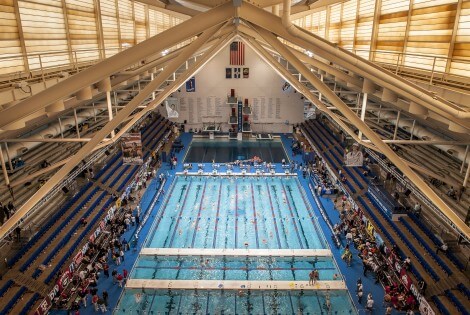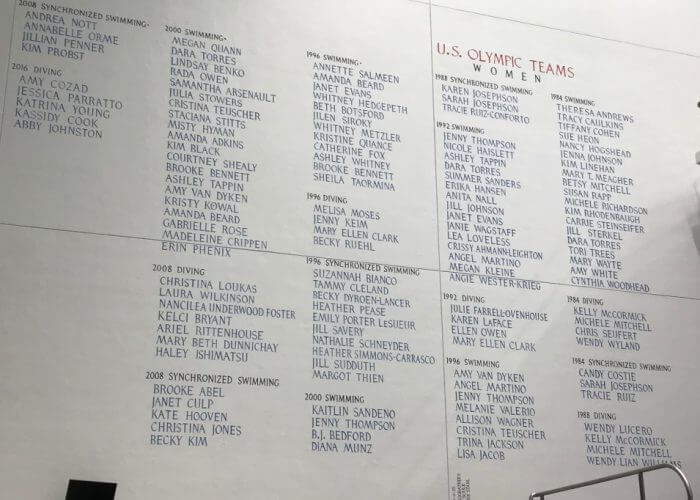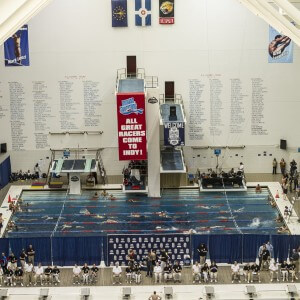Favorite Pools: John Lohn on the History and Aura of the Indiana University Natatorium

Favorite Pools. What are yours? As the swimming-less summer of 2020 draws on, the team at Swimming World will take a look at some of the great pools we love the most, why and what makes them so special. We’d like you to join in the fun and memories with your own suggestions, either by leaving a comment or sending us a picture you took of the venue you’ve chosen along with up to 300 words on why the place is one of your favorites: editorial@swimmingworld.com
- Craig Lord: Stadio Olimpico del Nuoto at the Foro Italico
- Ian Hanson: North Sydney Olympic Pool
- Andy Ross: William Woollett Aquatic Center
Today: John Lohn on the History and Aura of the Indiana University Natatorium
The moment I stepped through the doors, I was stunned.
Let’s get the details out of the way, as they should explain my initial reaction. The year was 2000, and I was a 23-year-old sportswriter for the Delaware County Daily Times, a mid-sized newspaper in the Philadelphia suburbs. My assignment: Cover the 2000 Olympic Trials in Indianapolis.
Specifically, I was in Indy to cover the efforts of Maddy Crippen and Brendan Hansen, contenders for Olympic Games berths in Sydney. Crippen was a product of the famed Germantown Academy Aquatic Club and mentored by legendary coach Dick Shoulberg. Hansen, meanwhile, had just graduated from high school and was on his way to the University of Texas.
By the time of Trials, I had covered swimming for three years, including during my college days, when I worked as a correspondent for the newspaper. Now, I was a staff member and I knew the ins and outs of Crippen’s and Hansen’s careers, and eagerly embraced the opportunity to cover their pursuits in Indianapolis.
But when I entered the Indiana University Natatorium for the first time, I didn’t know how to react. Until then, I had only been in college and high school pools. Now, I was staring at a 4,700-seat venue that was then known as the Mecca of the sport in the United States. During this last day before competition, I saw the likes of Tom Dolan, Dara Torres, Jenny Thompson and Ed Moses. I saw the iconic wall behind the diving boards. All in all, it was one hell of a sight.

Photo Courtesy: Peter H. Bick
The Indiana University Natatorium was built in 1982, as part of Indianapolis’ hosting duties of the National Sports Festival. It didn’t take long for the venue to earn its place in aquatic sports lore, as it served as host for the 1984 Olympic Trials in swimming, and subsequently held additional Trials in 1992, 1996 and 2000. It has also been the host to Olympic Trials in diving.
Athletes have spoken of the facility as the hub of swimming in the United States, a distinction it can easily claim given the fact that it has welcomed the following in addition to Olympic Trials: USA Swimming National Championships; NCAA Championships; Pan American Games; Duel in the Pool; Pro Series events; and more.
“I remember walking in and thinking, ‘Oh, my God.’ I’d never seen anything like it before,” once said Torres, who was a teenager the first time she saw the pool. I had never seen so many seats. It was always loud and sort of boisterous, which was great. When you go to swim meets outdoors, you don’t hear the crowd as much, but in there, it’s magical.”
While “The Nat” was the epicenter of Swim Trials through 2000, the growth of the sport took that special identity from the venue beginning in 2004. It was then that USA Swimming opted for the temporary-pool setup that has been so successful for Trials, first on a parking lot in Long Beach, California in 2004, followed by a shift to Omaha, Nebraska beginning in 2008, and carrying into present day.
Still, the Indiana University Natatorium is a meaningful place. In the swimming-rich state of Indiana, high schoolers get the chance to contest their state championships in the pool. Kids can attend camps there. Collegians often get a taste at the NCAA Championships. Others, meanwhile, are introduced when USA Swimming brings its meets to Indy. And anyone who has competed there in the past certainly has memories of their visits.
The pool has long been known as fast, and has been the sight of double-digit world records, including global standards by the likes of Michael Phelps, Aaron Peirsol, Thompson, Katie Ledecky and Pablo Morales. In 2003, the best of Australia got a sense of the building during the Duel in the Pool, that showdown producing a Phelps world record in the 400 individual medley.
Simply, there is an aura to the place, even if the air was not always top notch before an overhaul of the ventilation system in the past few years. Athletes, coaches, fans and journalists know that greatness was both experienced and launched in the place. To the sport of swimming, it is akin to baseball’s Fenway Park and Wrigley Field, or in football to Green Bay’s Lambeau Field.

The wall of Olympians. Photo Courtesy: Indiana University
The beauty of the Indiana University Natatorium is that it has appealed to swimmers of various levels and ages, but there is a certain aspect of the venue that is dedicated to the best of the best: The Wall. Behind the diving boards, the wall is adorned with the names of all American athletes who have qualified for the Olympic Games during competition at “The Nat.” Rowdy Gaines. Mary T. Meagher. Tracy Caulkins. Matt Biondi. Janet Evans. These are just some of the names that adorn the wall.
Through 2016, 249 names have been placed on the wall, a calligrapher performing the honors. For the athletes, the addition of their name is a symbolic gesture they have reached the pinnacle of their sport by earning an Olympic nod. For all, The Wall serves as a walk through history, as a reminder of the greats who have been dedicated to their craft and have provided the fans with some special to witness.
As far as first major meets go, the 2000 Olympic Trials were a dream to cover, especially for a young sportswriter. I’m not sure it was for the duration of the meet, but I sat next to Paul McMullen of the Baltimore Sun on at least a few nights. That seating assignment in the press section turned out to be a terrific turn of good fortune. First, McMullen was beyond kind to the 23-year-old kid who was wide-eyed and finding his way at a major event. Second, one of the stories McMullen covered in Indy was the arrival of a 15-year-old kid named Michael Phelps, and to see a veteran journalist handle this assignment was a true learning experience. I saw him communicate with the desk back in Baltimore, handle deadline under pressure and basically introduce the world to an athlete who would become the greatest Olympian in history.
Beyond Phelps, the rivalry between Torres and Thompson was a significant storyline. Not only was Torres making her first comeback, she and Thompson were so competitive training together under coach Richard Quick that they had to be moved into separate training slots during the leadup to the Olympic Trials. Meanwhile, the meet witnessed the emergence of American stars Aaron Peirsol, Anthony Ervin, Ian Crocker, Erik Vendt and Klete Keller. With Phelps, they became the Sydney Six.
During that assignment, Crippen made the Olympic team on the opening night, finishing second to Kaitlin Sandeno in the 400 individual medley. As for Hansen, he was an agonizing third place in both breaststroke events, although those finishes set him on a mission and fueled his rise as one of the great breaststrokers in history.

Photo Courtesy: Peter H. Bick
I remember watching Gary Hall Jr. do his thing in 2000, playing to the crowd and showing off his epic sprint speed with an American record in the 50 freestyle. Years later, I remember watching Phelps go 53.01 in the 100 backstroke at the 2007 Summer Nationals, that time a mere .03 off Peirsol’s world record. It was a head-shaking performance and spoke even more to Phelps’ versatility.
On a personal level, the Indiana University Natatorium holds a unique place in my heart. It was my first chance to cover this great sport on a major level, and I had the chance to see some all-timers do what they do at a degree foreign to most who ever dive into a pool. I’ve been lucky to cover – on site – three Olympiads, various World Championships, the Pan Pacific Championships, and so on. They’ve all been great.
But the Indiana University Natatorium is my favorite, for sentimental reasons as much as for what has unfolded within its walls. I’m not sure when I’ll next get there, but I look forward to the day. I look forward to walking through the doors again and feeling stunned, just like my first visit.
.




John, Great article. An idea for an article would be to do a history of the old Belmont Plaza in Long Beach. That pool – not USC’s, Woolett, Mission Viejo, UCLA’s – is the most important in SoCal in the past 75 years. Olympic Trials, Pac-10’s, CIF meets (often with the fastest swimmers in the country/Many, many Olympians), CIF Water Polo for many years, Speedo Cup and on and on and on. I think it would be a great article.
The first time I stepped into the Texas Swim Center (Now Lee & Joe Jamail) a few years before IUPUI came on line, it had the same “gasp” reflex for me as you describe for your first time in Indy. I still think the Texas tank is at least the equal of Indy as a speedy pool, if not superior, and has been a huge factor in their sustained excellence since the pool debuted. In six years, Eddie Reese had brought Auburn up from no SEC points to an NCAA second place finish in 1978. He recognized the value of a Taj Majal facility and took the Texas job when the pool opened in 1979. They were 21st that opening year, but by his third year the Longhorns won his 1st of 15 NCAA titles … to date. Eddie is obviously one of the best coaches of all-time. His consistency in having 35 top 3 finishes across 44 seasons is unmatched. The Auburn men fell steadily over the next decade to being a non-scorer in 1990. The school responded to this nadir at least in part by going through the process necessary to open a new and competitive pool (James E. Martin Aquatic Center) in 1993. It had to contribute to the advancement of their process to conseccutive NCAA titles in 1996 and 1997. Pools matter to both program development and sustainability.
Indy was the result of a political loss for Indiana coaching great Dr. James E. “Doc” Counsilman. He had been working for years to leverage the success of his program (six consecutive NCAA titles from 1968 through 1973, after multiple years in the early ’60s where he had the best collection of swim athletes in the world at IU but could not compete for NCAA titles due to penalties imposed for recruiting improprieties in the FOOTBALL program) to get a new pool on the Bloomington campus, about 40 miles south of Indianapolis. IU continued to train in the 6 lane SCY Royer Pool, with separate diving tank limited to springboards and a 5 meter tower, so close to the ceiling that the better divers could play with the acoustic tiles overhead.
My second-hand understanding is tha a combination of factors, including fuzzy focused administrators who thought they could serve all needs, including IU’s, by setting the location in Indianapolis where a major donor (Eli Lilly?) desired that it be placed and could be used as part of the bid presentations for both the 1982 National Sports Festival and the 1987 Pan American Games and has subsequesntly been host to numerous major pool based aquatic discipline competitions. Indiana Sports Corporation and others have done a great job over time of gathering many events to keep it from becoming a beautiful white elephant of limited use to either Indiana U or Purdue, and while just outside range of being reliably useful to either of those Big10 schools, it has been a fine home to the top ranked D-2 IUPUI Greyhounds and also top ranked Carmel High School. Not many D-2 universities or high schools get to be the primary users of such an athletic palace.
It took another 15 years after IUPUI opened before the Bloomington campus finally received a new, more competitive tank, when the Counsilman Billingsley facility opened in 1996. Sadly this was just over a half-decade too late for the namesakes of the pool, Doc Counsilman and Hobie Billingsley, to coach in it, after being hemmed in at Royer through their 30+ year careers in service to IU.
Belmont is another story to long to tell here and now.
Thanks Matt. That is a great idea and I will discuss it with the team. Thank you for pointing out the significance and variety of meets hosted.
Tommy Nowakowski
Of course its a great pool, would you think anything else??
Tommy Nowakowski it’s where Mike swam in Olympic trials too!
Heather Raley no way!?
Tommy Nowakowski
Heather Raley thats Indianapolis that isn’t at IU! I thought it was the IU pool
Tommy Nowakowski it says “Indiana University Natatorium” lol
The pool is in Indy but is known as the IU Natatorium
It’s IUPUI (Indiana University Purdue University Indianapolis)
It is an awesome pool!
In 1982 I was lucky enough to see my sister, Karin LaBerge win the 1500 with the worlds fastest time At LC Nationals that year. Dick Schoulberg has coached many Olympians but I’m proud to say that Karin was his first in 1980. It was a thrill to see her win take her first Nationals in that pool
Mention should be made of the 100m pool in Cuyahoga Falls, Ohio. It was later permanently divided at the 50m mark to create two pools. It was the site of the 1962 Nationals.
I worked the ready room in 2000 Trials and never saw one race. It was the great swim experience of my life.